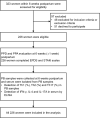Blood T-helper 17 cells and interleukin-17A correlate with the elevated risk of postpartum depression and anxiety
- PMID: 35708016
- PMCID: PMC9279994
- DOI: 10.1002/jcla.24559
Blood T-helper 17 cells and interleukin-17A correlate with the elevated risk of postpartum depression and anxiety
Abstract
Background: T-helper (Th) cells regulate inflammation and immunity, which is implicated in psychological disorders. The current study aimed to explore the clinical role of blood Th1, Th2, and Th17 cells and their main secreted cytokines in postpartum depression (PPD) and postpartum anxiety (PPA).
Methods: A total of 226 postpartum women were included. At 6 weeks postpartum, Edinburgh Postnatal Depression Scale (EPDS) and State Trait Anxiety Inventory 6 item version (STAI6) scores were assessed; meanwhile, blood Th1, Th2, and Th17 cells were detected by flow cytometry, serum interferon-gamma (IFN-γ), interleukin-4 (IL-4), and IL-17A were detected by enzyme-linked immunosorbent assay.
Results: The incidence of PPD and PPA were 24.3% and 27.9%, respectively. Th17 cells and IL-17A were positively correlated with EPDS score and STAI6 score (all p < 0.001). Besides, Th17 cells (p < 0.001) and IL-17A (p = 0.002) were increased in PPD cases vs. non-PPD cases, and they were also elevated in PPA cases vs. non-PPA cases (both p < 0.05). However, Th1 cells, Th2 cells, IFN-γ, and IL-4 were not linked with EPDS score or STAI6 score (all p > 0.05); besides, they did not vary in PPD cases vs. non-PPD cases or in PPA cases vs. non-PPA cases (all p > 0.05). Multivariate logistic regression model analysis showed that Th17 cells were independently associated with an elevated risk of PPD (odds ratio [OR] = 1.600, p = 0.001) and PPA (OR = 1.371, p = 0.022).
Conclusion: Blood Th17 cells and IL-17A are positively linked with the risk of PPD and PPA, indicating which may be involved in the development of PPD and PPA.
Keywords: T-helper cells; cytokines; postpartum anxiety; postpartum depression; risk factors.
© 2022 The Authors. Journal of Clinical Laboratory Analysis published by Wiley Periodicals LLC.
Conflict of interest statement
The authors declare that they have no competing interests.
Figures






Similar articles
-
Circulating JKAP levels may correlate with postpartum anxiety and depression through its interaction with T helper 17 cells.Braz J Med Biol Res. 2024 Oct 7;57:e13253. doi: 10.1590/1414-431X2024e13253. eCollection 2024. Braz J Med Biol Res. 2024. PMID: 39383378 Free PMC article.
-
Blood Th17 cells and IL-17A as candidate biomarkers estimating the progression of cognitive impairment in stroke patients.J Clin Lab Anal. 2022 Aug;36(8):e24581. doi: 10.1002/jcla.24581. Epub 2022 Jul 9. J Clin Lab Anal. 2022. PMID: 35808926 Free PMC article.
-
T-Helper 22 Cell Type Responses to Nickel in Contact Allergic Subjects Are Associated with T-Helper 1, T-Helper 2, and T-Helper 17 Cell Cytokine Profile Responses and Patch Test Reactivity.Int Arch Allergy Immunol. 2023;184(8):832-840. doi: 10.1159/000530105. Epub 2023 Apr 27. Int Arch Allergy Immunol. 2023. PMID: 37105142 Free PMC article.
-
Th17 Cells and IL-17A in Ischemic Stroke.Mol Neurobiol. 2024 Apr;61(4):2411-2429. doi: 10.1007/s12035-023-03723-y. Epub 2023 Oct 26. Mol Neurobiol. 2024. PMID: 37884768 Free PMC article. Review.
-
Targeting the Adaptive Immune System in Depression: Focus on T Helper 17 Cells.Pharmacol Rev. 2022 Apr;74(2):373-386. doi: 10.1124/pharmrev.120.000256. Pharmacol Rev. 2022. PMID: 35302045 Free PMC article. Review.
Cited by
-
Th17 Cells, Glucocorticoid Resistance, and Depression.Cells. 2023 Nov 30;12(23):2749. doi: 10.3390/cells12232749. Cells. 2023. PMID: 38067176 Free PMC article. Review.
-
Biomarkers of Postpartum Depression: A Narrative Review.J Clin Med. 2023 Oct 14;12(20):6519. doi: 10.3390/jcm12206519. J Clin Med. 2023. PMID: 37892657 Free PMC article. Review.
-
Recent Progress in Biosensors for Depression Monitoring-Advancing Personalized Treatment.Biosensors (Basel). 2024 Aug 30;14(9):422. doi: 10.3390/bios14090422. Biosensors (Basel). 2024. PMID: 39329797 Free PMC article. Review.
-
Selected Biomarkers of Depression: What Are the Effects of Cytokines and Inflammation?Int J Mol Sci. 2022 Dec 29;24(1):578. doi: 10.3390/ijms24010578. Int J Mol Sci. 2022. PMID: 36614020 Free PMC article. Review.
-
Biomarkers of reproductive psychiatric disorders.Br J Psychiatry. 2025 Jun;226(6):352-368. doi: 10.1192/bjp.2025.134. Epub 2025 Jun 20. Br J Psychiatry. 2025. PMID: 40538358 Free PMC article. Review.
References
-
- Daly D, Moran P, Wuytack F, et al. The maternal health‐related issues that matter most to women in Ireland as they transition to motherhood ‐ a qualitative study. Women Birth. 2022;35(1):e10‐e18. - PubMed

